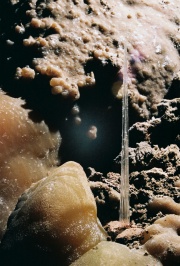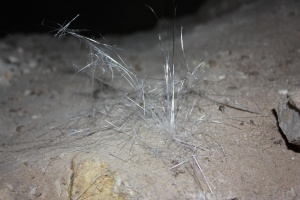Gypsum (Inventory)/Needle
From LagWiki
(Minor correction) |
|||
| Line 14: | Line 14: | ||
*Hill, Carol; Paolo Forti (1997) ''Cave Minerals of the World (Second Edition ed.)'' National Speleological Society pp 103-104 ISBN: [[Special:Booksources/1-879961-07-5|1-879961-07-5]] | *Hill, Carol; Paolo Forti (1997) ''Cave Minerals of the World (Second Edition ed.)'' National Speleological Society pp 103-104 ISBN: [[Special:Booksources/1-879961-07-5|1-879961-07-5]] | ||
*Palmer, Arthur N. (2007) ''Cave Geology'' CAVE BOOKS, Dayton, OH pp 290-291 ISBN-13: [[Special:Booksources/978-0-939748-66-2|978-0-939748-66-2]], ISBN-10: [[Special:Booksources/0-939748-66-5|0-939748-66-5]] | *Palmer, Arthur N. (2007) ''Cave Geology'' CAVE BOOKS, Dayton, OH pp 290-291 ISBN-13: [[Special:Booksources/978-0-939748-66-2|978-0-939748-66-2]], ISBN-10: [[Special:Booksources/0-939748-66-5|0-939748-66-5]] | ||
| + | |||
| + | ==Needle, Gypsum== | ||
| + | <gallery perrow=1 widths=300px heights=200px> | ||
| + | File:Gypsum needles.JPG|Gypsum needles. These are fine enough that they could be inventoried as [[Gypsum (Inventory)/Cotton/Hair|Gypsum Cotton/Hair]]. | ||
| + | </gallery> | ||
{{Cave inventory}} | {{Cave inventory}} | ||
Current revision as of 17:38, 28 April 2014
The Needle field of the Gypsum section should be used to record any stations that exhibit gypsum needles.
Gypsum needles (also known as selenite needles) are thin blades of gypsum that look like needles. They are straight and can vary in length from a few milimeters to several meters in length in rare cases. The color is usually clear but shorter varieties can grow in mud and be stained by the mud itself. Gypsum needles are closely related to gypsum cotton and hair and often occur in proximity.
Gypsum needles seem to grow upward from floor sediments and soils seeming to push aside the individual grains of soil as they grow. However, they can also be found on bedrock in the floor, on walls or even on the ceiling and growing from other speleothems where they often lie flat and radiate in clusters.
Examine closely to notice these delicate speleothems especially where other gypsum formations are found and floor sediments are present.
See also
References
- Hill, Carol; Paolo Forti (1997) Cave Minerals of the World (Second Edition ed.) National Speleological Society pp 103-104 ISBN: 1-879961-07-5
- Palmer, Arthur N. (2007) Cave Geology CAVE BOOKS, Dayton, OH pp 290-291 ISBN-13: 978-0-939748-66-2, ISBN-10: 0-939748-66-5
Needle, Gypsum
Gypsum needles. These are fine enough that they could be inventoried as Gypsum Cotton/Hair. |


